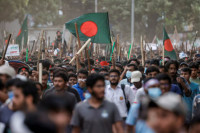Mon, Jan 5, 2026
Opinion
Tribute to Lord Shiva
The Maha Shivaratri festival marks the overcoming of darkness and ignorance in life
bookmark
Niranjan Mani Dixit
Published at : February 18, 2018
Updated at : February 18, 2018 08:25
The most sanctified Hindu pilgrimage in the Himalaya is the Pashupatinath Temple which houses a sacred Linga or holy symbol of Lord Shiva. Devotees maintain an all-night vigil on the auspicious day of Maha Shivaratri which fell on February 13 this year. The festival marks the overcoming of darkness and ignorance in one’s life. The holy text Shiva Purana which glorifies Lord Shiva was written by Ved Byas who lived in a hermitage known as Byas Cave in central Nepal.
Among the three deities, Brahma, who creates the universe, Vishnu who preserves the universe, and Shiva, though considered as the ‘destroyer’ also symbolises the inner self which remains intact even after everything ends. The divine play of Lord Shiva who pierced the three worlds by creating a huge endless pillar of light, or the Jyotirlinga, made Brahma and Vishnu understand that there was a mightier ‘third power’ that ruled the universe. The Shiva Purana states that the Shivalinga (an aniconic representation of Shiva) is the bestower of all wishes. The Jyotirlinga at Pashupatinath in Kathmandu is the head over the body of the 12 Jyotirlingas found in India.
Shiva spends his time in deep meditation in the Himalaya including Mt Kailash. His calm state of mind is sometimes disturbed due to extreme reasons. The image of Lord Rama, who is of dark complexion, is reflected in the heart of Lord Shiva. Lord Shiva’s meditational devotion to Lord Ram is perpetual. Lord Rama accepted Lord Shiva as his Ishwar in Rameshwaram where he had established a Lingam to show his intense devotion towards his Lord. When the Mahabharata righteous war between the Pandavas and the Kauravas was about to commence, Sri Krishna prayed for Shiva’s blessing by organising a Shiva Pooja.
Many forms
Shiva (Shankar) is also Nataraja, the Lord of Dance, who transformed into a charming Gopi and left his abode on Kailash to witness Lord Krishna and Radha having their Maha Raas Lila, a transcendental dance of passion. Shiv-Tandav, the cosmic dance, is symbolic of the triumph of Truth (Satya) over ignorance and impermanence, so elevating and energising the entire universe, adding life to matter. It dispels the clouds of ignorance and instils faith, hope and wisdom, banishing the sufferings of his followers and making them find the light inside their beings. Lord Shiva’s devotion to Lord Rama is so complete and unique that when Lord Vishnu descended to earth as Rama, Lord Shiva took the form of the monkey god Hanumana to serve his master.
Shiva revealed himself as Neelkantha (the blue throated) by swallowing the poison that emerged from the churning of the sea by the Gods and the Demons. Shiva is also known to be the most innocent Bhole Nath, Bhole Baba or Phakkar Baba (indigent and tension free) or Ashutos (highly compassionate and merciful). Lord Shiva always shunned wealth and materialistic happiness as desires lead to obsessions, and obsessions lead to destruction or self-destruction. The Creator of the three worlds, Shiva himself is uncreated. All three worlds, including time and space, dissolve in Shiva. The five faces of Pashupatinath which face west, north, east, south and the zenith represent Hinduism’s five primary elements, namely earth, water, air, light and ether, respectively.
An ascetic to the core
Lord Shiva has ash smeared all over his body, snakes are coiled around his head and arms, he wears tiger and elephant skins, and also leads a wild life in the cremation grounds far removed from social pretences. Shiva’s accessories include a Trishul (trident) and Damaru, a two-headed small drum, which he uses to produce spiritual sounds. Shiva wears a garland of Rudraksha beads which represent the tears he shed when he woke up from deep meditation with a desire to help the worlds. Shiva tamed the mighty river Ganga by standing between heaven and earth, and capturing it in his thick locks and stemming its flow to prevent the earth from becoming parched and dry.
Shiva has an ascetic disposition. The three aspects of Sada-Shiva, the eternal Lord responsible for creation, preservation and destruction of the world, are represented by the trifoliate leaves of the bael tree (wood apple). The leaves are also used when worshipping Shiva and represent his three eyes, the third being located at the centre of the forehead. God of Gods (Devadi Deva Mahadev), His existence symbolises Infinity. The Temple of Guhyashwori, Goddess Sati/Durga consort of Shiva, lies east of the Pashupatinath Temple on the banks of the sacred Baghmati River. A true tribute to Lord Shiva would be to introspect and examine oneself so that ignorance, unethical deeds and demonic tendencies are eliminated, and peace, prosperity and happiness for all are secured.
Dixit is an expert in integrated development issues
Most Read from Opinion
Editor's Picks
E-PAPER | January 05, 2026
×




 15.76°C Kathmandu
15.76°C Kathmandu












